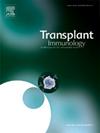CD45RA+FOXP3low naïve和CD45RA−FOXP3high - effector/memory Treg亚群在异基因造血干细胞移植后急性移植物抗宿主病发生中的临床意义
IF 1.4
4区 医学
Q4 IMMUNOLOGY
引用次数: 0
摘要
有研究认为,调节性T细胞(Tregs)可能参与了异基因造血干细胞移植(alloo - hsct)后移植耐受的诱导。然而,对于Treg亚群在同种异体造血干细胞移植结果中的作用,包括急性移植物抗宿主病(aGVHD)的发展,我们知之甚少。在此,我们首次评估了调节性T细胞(Treg)亚群的频率,包括CD45RA+FOXP3low naïve (nTregs)和CD45RA−FOXP3high effector/memory Tregs (eTregs),与alloo - hsct后90天aGVHD发生之间的关系。方法入选24对恶性血液病供体/受体,接受hla匹配的同种异体造血干细胞移植。通过四色流式细胞术检测nTregs和eTregs的频率。结果与非aGVHD患者相比,aGVHD患者供体中出现nTregs的频率较低(*P = 0.016)。与非aGVHD患者相比,aGVHD患者在同种异体造血干细胞移植后第60天的nTregs重构率显著降低(*P = 0.025)。移植后第30天nTregs<;0.19,中位频率为nTregs<;0.13,中位频率为eTregs<;0.58的患者,aGVHD的累积发病率相对较高(*P = 0.039, *P = 0.032, *P = 0.036)。多因素分析显示,同种异体造血干细胞移植后+30和+ 60天恢复的Tregs中位数较低与aGVHD发病率增加相关[HR = 0.199, 95% CI, 0.041-0.969;*P = 0.046, HR = 0.092, 95% CI, 0.011-0.765;*P = 0.026]。结论本研究提供了新的见解,表明高供体nTreg含量和移植后30天早期nTreg和etreg的快速恢复与aGVHD的保护密切相关。本文章由计算机程序翻译,如有差异,请以英文原文为准。
The clinical significance of CD45RA+FOXP3low naïve and CD45RA−FOXP3high effector/memory Treg subsets in the development of acute graft-versus-host disease after allogeneic hematopoietic stem cell transplantation
Introduction
It has been proposed that regulatory T cells (Tregs) might be involved in the induction of transplantation tolerance after allogeneic hematopoietic stem cell transplantation (allo-HSCT). However, little is known about the role of Treg subsets in allo-HSCT outcomes, including the development of acute graft-versus-host disease (aGVHD). Herein, we assessed for the first time the association between the frequency of regulatory T cell (Treg) subsets, including CD45RA+FOXP3low naïve (nTregs) and CD45RA−FOXP3high effector/memory Tregs (eTregs), and aGVHD occurrence during 90 days after allo-HSCT.
Methods
Twenty-four pairs of donors/recipients with hematologic malignancies who underwent HLA-matched allo-HSCT were enrolled. The frequencies of nTregs and eTregs were determined via four-color flow cytometry.
Results
Compared with non-aGVHD patients, aGVHD patients had a lower frequency of nTregs in their donors (*P = 0.016). The reconstitution rate of nTregs was significantly slower on day +60 post-allo-HSCT in aGVHD patients than in non-aGVHD patients (*P = 0.025).
Patients who received grafts with nTregs<0.19 and a median frequency of nTregs<0.13 and eTregs<0.58 on day +30 after transplantation presented a relatively high cumulative incidence of aGVHD (*P = 0.039, *P = 0.032, and *P = 0.036, respectively). Multivariate analysis revealed that a low median total number of Tregs recovered on days +30 and + 60 post-allo-HSCT was associated with an increased incidence of aGVHD [HR = 0.199, 95 % CI, 0.041–0.969; *P = 0.046 and HR = 0.092, 95 % CI, 0.011–0.765; *P = 0.026, respectively].
Conclusion
This study provides novel insights showing that high donor nTreg content and rapid recovery of nTregs and eTregs early on day 30 post-transplantation are closely linked to protection from aGVHD.
求助全文
通过发布文献求助,成功后即可免费获取论文全文。
去求助
来源期刊

Transplant immunology
医学-免疫学
CiteScore
2.10
自引率
13.30%
发文量
198
审稿时长
48 days
期刊介绍:
Transplant Immunology will publish up-to-date information on all aspects of the broad field it encompasses. The journal will be directed at (basic) scientists, tissue typers, transplant physicians and surgeons, and research and data on all immunological aspects of organ-, tissue- and (haematopoietic) stem cell transplantation are of potential interest to the readers of Transplant Immunology. Original papers, Review articles and Hypotheses will be considered for publication and submitted manuscripts will be rapidly peer-reviewed and published. They will be judged on the basis of scientific merit, originality, timeliness and quality.
 求助内容:
求助内容: 应助结果提醒方式:
应助结果提醒方式:


